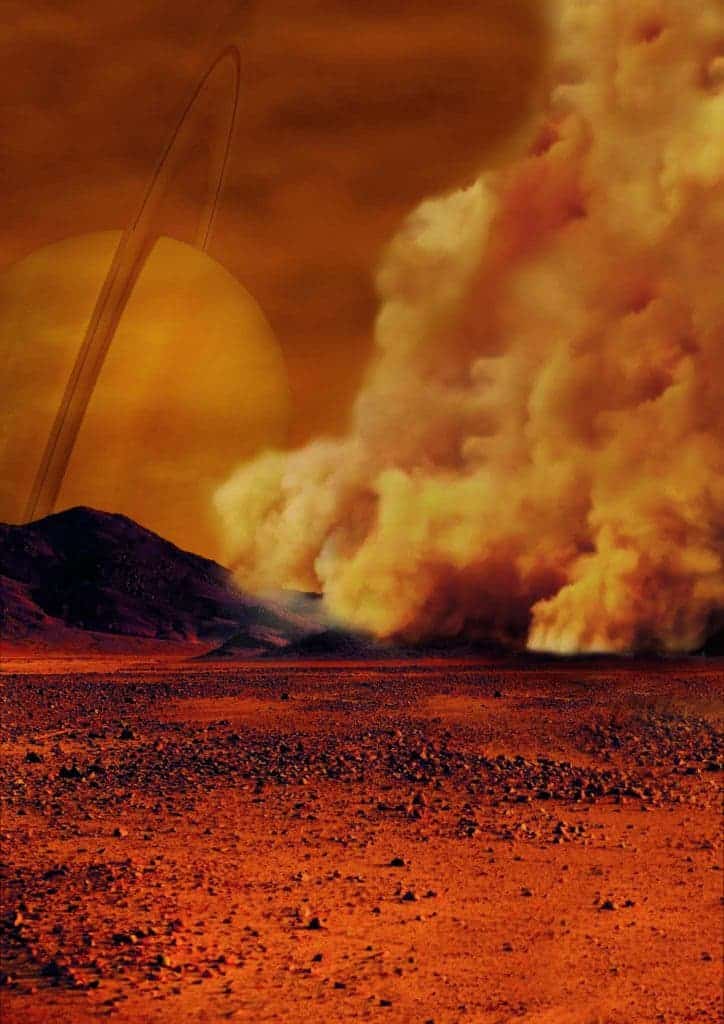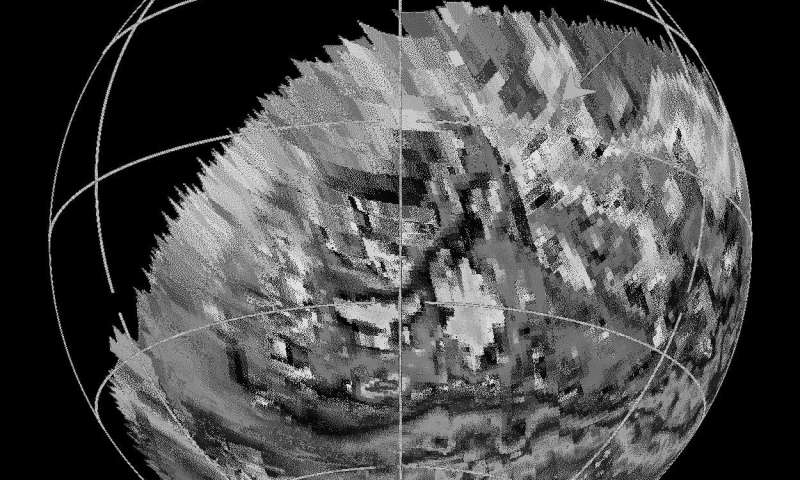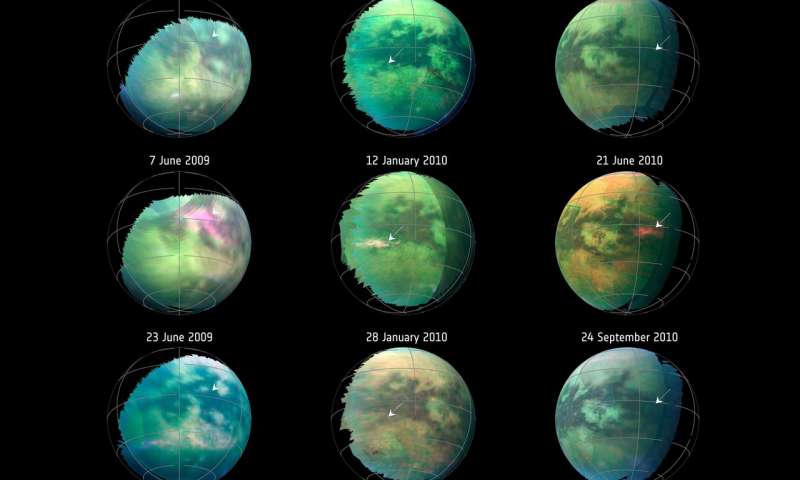
Artist impression of a dust storm on Titan. Credit: IPGP/Labex UnivEarthS/University Paris Diderot – C. Epitalon & S. Rodriguez.
Although Titan is a moon, it has an intriguing geology and, in many aspects, is very similar to Earth. Titan has a substantial atmosphere and is the only body in the solar system other than Earth to host stable liquid (in its case, methane) on its surface. Now, researchers have identified giant dust storms in equatorial regions of Saturn’s moon. This makes Titan the third object in the solar system, along with Earth and Mars, where such a meteorological phenomenon has been observed.
Dust storms on Titan
Titan has active weather that changes from season to season, particularly during the equinox — the time when the sun crosses Titan’s equator — when massive clouds of methane and ethane can cause powerful storms in the moon’s tropical regions.
[panel style=”panel-info” title=”Titan: a strange world” footer=””]Titan is the only known moon with a fully developed atmosphere that consists of more than just trace gases. Titan’s temperature is about 94 K (−179 °C, or −290.2 °F) at the surface. At this temperature, water ice does not sublimate from solid to gas, so the atmosphere is nearly free of water vapor. “You have all these things that are analogous to Earth. At the same time, it’s foreign and unfamiliar,” said Ray Pierrehumbert, the Louis Block Professor in Geophysical Sciences at Chicago.[/panel]
During its numerous flybys of Titan, NASA’s Cassini spacecraft recorded many such storms. However, on one occasion, it spotted three unusual equatorial brightenings with its infrared instruments. At the time, in 2009, scientists thought these were some kind of methane clouds — but a subsequent examination revealed that they were dealing with something totally different.
The features were not frozen methane rain or icy lavas, either, because they did not match the chemical signature and should have remained visible for much longer than the bright features observed in the study. These appeared for only 11 hours to five weeks.

Bright spots recorded in infraded by NASA’s Cassini mission between 2009 and 2010. Credit: NASA/JPL-Caltech/University of Arizona/University Paris Diderot/IPGP/S. Rodriguez et al. 2018.
Modeling of the bright features also showed that the features must be atmospheric but still close to the surface, forming a thin layer of solid organic particles. Finally, because the features were located right above dune fields on Titan’s equator, the authors of the new study concluded that the only viable explanation remaining was that the spots were actually clouds of dust.
“Titan is a very active moon,” said Sebastien Rodriguez, an astronomer at the Université Paris Diderot, France, and the paper’s lead author. “We already know that about its geology and exotic hydrocarbon cycle. Now we can add another analogy with Earth and Mars: the active dust cycle, in which organic dust can be raised from large dune fields around Titan’s equator.”

Nine Cassini flybys of Titan in 2009 and 2010 show three instances when clear bright spots suddenly appeared in images taken by the spacecraft’s Visual and Infrared Mapping Spectrometer. Credit: NASA/JPL-Caltech/University of Arizona/University Paris Diderot/IPGP/S. Rodriguez et al. 2018.
Titan’s dust probably forms when organic molecules, resulting from methane’s interaction with sunlight, grow large enough to fall to the surface. In fact, Rodriguez says that one of NASA’s probe that touched down on Titan raised dust upon its landing — a first hint that dust storms were occurring on Saturn’s moon.
“We believe that the Huygens Probe, which landed on the surface of Titan in January 2005, raised a small amount of organic dust upon arrival due to its powerful aerodynamic wake,” said Rodriguez. “But what we spotted here with Cassini is at a much larger scale. The near-surface wind speeds required to raise such an amount of dust as we see in these dust storms would have to be very strong—about five times as strong as the average wind speeds estimated by the Huygens measurements near the surface and with climate models.”
Dust storms on Titan imply that the moon’s giant dunes are still active and continually changing. Wind could be transporting dust from far-away regions, triggering a global cycle of organic dust on the moon.
Scientific reference: S. Rodriguez et al. Observational evidence for active dust storms on Titan at equinox, Nature Geoscience (2018). DOI: 10.1038/s41561-018-0233-2.









